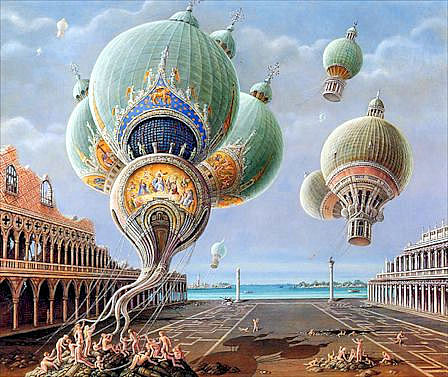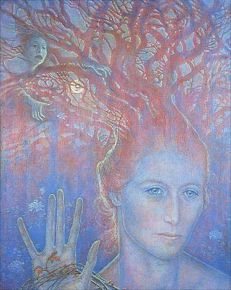| The Light Fantastic
Brigid Marlin, a painter of imaginative art, describes how she finds her subject matter within her own imagination A painter of imaginative and fantastic subjects is often asked: "Where do you get your ideas from?" This is usually followed by the comment: "I wish I had your imagination!" We all have the ability to imagine creatively, especially when we are children. Sadly, however, we often lose contact with that part of ourselves when we become
adults. One way of getting in touch again with this hidden self is to note down our dreams. It can help to keep a pencil and pad by the bed, because nothing vanishes as quickly as the memory of a dream. Most dreams will be unimportant, but a few will contain powerful imagery that can be used later in a painting. Another way is to look for pictures in the fire. Or throw a sponge loaded with paint at a canvas, and see if the result suggests an image — a bit like the Rorschach test, but it works! When your idea has begun to form, it is time to set it down. Only when you have taken the first step will inspiration come. Then the struggle begins. One of the hardest things to do is to depict a vision or a dream. So many ideas which seem wonderful in one’s head look banal or sentimental when painted. The initial idea First, the idea must have resonance, It is no good if it is just an idea in the head. Such an idea would be better expressed in writing. To make a good painting, the idea must come as a mystery, a sort of puzzle that needs to be solved. You must not know too soon the meaning of what you are painting; if there is a ‘message it will begin to look like a poster, It is also a bad idea to talk about the idea to anyone. It will grow better in secret. Finally, you have to make a start, otherwise nothing will happen! You must be prepared to make several false starts before the right image begins to take shape. Strangely, perhaps, you know when you are going wrong with a fantasy picture, but you are never absolutely sure when you are going right, until you hit on a format that seems to be going in the right direction, and which seems to tell you more about your idea than you had known up until then. As Wilde's Lady Bracknell said: "I don’t know what I mean until I hear what I say." A personal journey In the case
of the painting shown here (above left), I worked on a fairly large gesso
panel. I killed the white with a glaze of umber and red, and swirled the
paint around with my fingers. The shapes of the balloons seemed to form
themselves, and I wondered what they were. Then I suddenly saw St. Mark’s
Square in Venice, and realised that this was St. Mark’s Cathedral
floating away. I got hold of a photograph of St. Mark’s Cathedra , and
by holding a silver Christmas tree ornament to it, I saw in the reflection
how to paint it in the round. I painted the cathedral as a series of
balloons, with long streamers, like umbilical cords. Showing imaginative art For artists who like to work in the region of the fantastic and surrealism there are not many outlets. Such painting is often excluded or marginalised in most exhibitions. A good way to feel encouraged is to join forces with like-minded people, and meet for discussions and painting sessions. In fact a society has been formed recently with the express purpose of bringing together artists working in the fields of imaginative art, and enabling them to show their work to the public. Brigid Marlin is the founder of the Society for the Art of Imagination http://innervision.tripod.com. The society holds an annual exhibition at the Mall Galleries, London. The exhibition is open to all artists working in the realms of the fantasic, surreal and visionary. For more details and application forms write to: The Society for the Art of Imagination, |

 I achieved a beautiful transparent
look with the colours by painting the cathedral with white underpainting
and adding the colours as glazes on top. I used soft colours such as
Naples yellow, rose doré, cerulean blue, and a mixture of monestial
green, azure blue and yellow ochre for the domes. Then I realised that if
St. Mark’s was floating away, probably other churches were floating
away, too. I did some photographic research, and found other Venetian
churches to turn into balloons. I painted them against a light blue sky
— cerulean with lemon yellow near the horizon, and with ultramarine near
the top to make the kind of sky that you often see in Venice. In order to
add a little drama, I added clouds made with titanium white, permanent
rose and Payne’s grey. The next thing that occurred to me was that if
the churches had all left the ground, the place must look a mess, so
perhaps there had been some kind of disaster. Referring to a photograph of
St. Marks Square (above), I
I achieved a beautiful transparent
look with the colours by painting the cathedral with white underpainting
and adding the colours as glazes on top. I used soft colours such as
Naples yellow, rose doré, cerulean blue, and a mixture of monestial
green, azure blue and yellow ochre for the domes. Then I realised that if
St. Mark’s was floating away, probably other churches were floating
away, too. I did some photographic research, and found other Venetian
churches to turn into balloons. I painted them against a light blue sky
— cerulean with lemon yellow near the horizon, and with ultramarine near
the top to make the kind of sky that you often see in Venice. In order to
add a little drama, I added clouds made with titanium white, permanent
rose and Payne’s grey. The next thing that occurred to me was that if
the churches had all left the ground, the place must look a mess, so
perhaps there had been some kind of disaster. Referring to a photograph of
St. Marks Square (above), I began
to paint the disaster. By breaking off the corners of the buildings at
either side, I achieved a very powerful line of perspective. The buildings
were added using white underpainting and Indian red and permanent rose as
glazes on top. Then I made holes in the ground of the square for people to
crawl out of, but I couldn’t picture how they should be dressed.
Finally, I decided that they wouldn’t wear anything. Maybe after a
disaster like this they had lost their clothes! The next problem was the
shadow of the balloons on the ground. In order to be convincing, a fantasy
must conform to the ordinary laws of the world. As C. S. Lewis wrote:
"A myth must have the inner consistency of reality." Unless my
shadows were convincing, the whole painting would lack conviction.
Renaissance artists used to make tiny models in their studios and use them
to work out by analogy how things would look in the real world. So I
collected various scraps, some wax, toothpicks and plasticine, and made a
tiny model of the balloons. Then I took a strong lamp and held it near the
model. The shadow of the balloons was perfect, and completely different
from anything I could have imagined. I took a photograph, and when I
painted the shadows in the picture it took on a new feeling of reality.
Meanwhile, I had been struggling with the colours. Often, paintings of a
dream or nightmare are most effective if painted in nightmare colours. But
as this was a painting about Venice, my colours were soft Venetian pinks,
greens and blues. I debated whether to change things but judged that I
could get away with the same colours. Nevertheless, the painting still
needed one strong accent of colour. So I made the water a bright
turquoise, using monestial turquoise as a glaze. This seemed to bring the
whole picture together and it also emphasised the water element which is
such a huge part of Venice. When the picture was finished people asked me
what it meant. I don’t know; if you do know, what is the point of
painting a fantasy picture in the first place?
began
to paint the disaster. By breaking off the corners of the buildings at
either side, I achieved a very powerful line of perspective. The buildings
were added using white underpainting and Indian red and permanent rose as
glazes on top. Then I made holes in the ground of the square for people to
crawl out of, but I couldn’t picture how they should be dressed.
Finally, I decided that they wouldn’t wear anything. Maybe after a
disaster like this they had lost their clothes! The next problem was the
shadow of the balloons on the ground. In order to be convincing, a fantasy
must conform to the ordinary laws of the world. As C. S. Lewis wrote:
"A myth must have the inner consistency of reality." Unless my
shadows were convincing, the whole painting would lack conviction.
Renaissance artists used to make tiny models in their studios and use them
to work out by analogy how things would look in the real world. So I
collected various scraps, some wax, toothpicks and plasticine, and made a
tiny model of the balloons. Then I took a strong lamp and held it near the
model. The shadow of the balloons was perfect, and completely different
from anything I could have imagined. I took a photograph, and when I
painted the shadows in the picture it took on a new feeling of reality.
Meanwhile, I had been struggling with the colours. Often, paintings of a
dream or nightmare are most effective if painted in nightmare colours. But
as this was a painting about Venice, my colours were soft Venetian pinks,
greens and blues. I debated whether to change things but judged that I
could get away with the same colours. Nevertheless, the painting still
needed one strong accent of colour. So I made the water a bright
turquoise, using monestial turquoise as a glaze. This seemed to bring the
whole picture together and it also emphasised the water element which is
such a huge part of Venice. When the picture was finished people asked me
what it meant. I don’t know; if you do know, what is the point of
painting a fantasy picture in the first place?